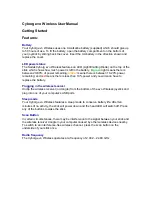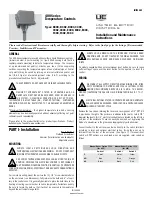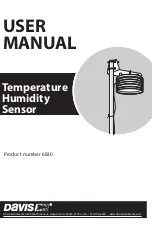
- 6 -
D. Install Dash Lamp
The Max Charge Dash Lamp (#17) terminal provides the ability to activate a visual or
audible indicator when the regulator monitors the following conditions: Low system
voltage, high system voltage, high alternator temperature and high battery tempera-
ture (temperature conditions are only indicated when appropriate temperature sen-
sors are connected). When a described condition is detected, the regulator sends the
Dash Lamp terminal from neutral to ground. To utilize the Dash Lamp func-
tion:
1.
Connect a small LED or incandescent lamp, or an audible (piezo) alert (maxi-
mum current flow is 500 mA) to a positive voltage source.
2.
Connect the negative terminal on the lamp or audible alert to the Dash Lamp
terminal on the regulator.
3.
When connected, the lamp should flash at
regulator start-up to indicate active sta-
tus.
B. Install Battery Temperature Sensors
Optional Battery Sensors (MC-TS-B) allow your Max Charge voltage regulator to mon-
itor battery temperatures. The Max Charge is equipped with terminals to monitor two
battery banks. The MC-TS-B sensor assmbly includes a 240” cable, a sensing attach-
ment lug and positive and negative regulator plug-in connectors. When connected to
Battery 2 Temp (#14) on the regulator, the temperature sensor will monitor for over-
temperature conditions only. Typically, Battery 2 Temp is used to monitor the starting
battery. Should an over-temp condition occur, the regulator will respond by ceasing
charging output to the batteries.
Battery 1 Temp will also monitor for, and respond to battery over-temp conditions by
ceasing charging output. In addition, the Battery 1 Temp circuit will also increase or
decrease charging voltage if it senses that ambient battery temperature is warmer or
colder than 75°F. The Battery 1 Temp circuit (#15) is recommended for use with the
house battery bank. To install the MC-TS-A:
1.
Connect the sensor lug to the negative post of your house battery. See photo above. If there
are multiple batteries in the bank, place the sensor lug on the negative terminal CLOS-
EST to the center of the battery bank.
2.
Extend sensor cable to the regulator.
3.
Connect the positive and negative female connectors to the appropriate Battery Temp.
Sense terminals on the regulator (#14 or #15). It is essential that the terminals match the
polarity of the regulator connection pins (red wire to positive terminal and black wire to
negative terminal). See the legend on the side of the regulator to determine terminal
polarity.
C. Install Aux. 1 Lamp
The Max Charge Aux. 1 (#16) terminal provides the ability to use a visual indicator
when the regulator is operating under the following conditions: Full field (the alterna-
tor is working at full power), Small Engine Mode (the regulator is being controlled at
50% field output), or Equalization Mode (the batteries are being intentionally over-
charged to remove sulfation. When a described condition is detected, the regulator
sends the Aux. 1 terminal from neutral to ground. To utilize the Aux. 1 Lamp function:
1.
Connect a small LED or incandescent lamp (maximum current flow is 500 mA) to a posi-
tive voltage source.
2.
Connect the negative terminal on the lamp to the Aux. 1 terminal on the regulator.
Alarm Output Functions
Alarm Output (Dash Lamp)
(-) 0.5 amp - when in alarm mode
• Low battery voltage (030)
• High battery voltage (040)
• High temperature at battery #1
• High temperature at battery #2
• High temperature at alternator
Aux. #1 (Advisory) Output
(-) 0.5 amp - when in alarm mode
• Alt. output at full capacity
• Small engine option activated
• Equalization mode activated
Summary of Contents for Max Charge MC-612
Page 15: ...15...



































